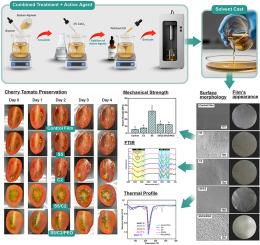Enhanced sodium alginate-Based active packaging films via sonication, CaCl2 crosslinking, and patchouli essential oil incorporation
IF 6.8
3区 材料科学
Q1 MATERIALS SCIENCE, MULTIDISCIPLINARY
Journal of Science: Advanced Materials and Devices
Pub Date : 2025-08-09
DOI:10.1016/j.jsamd.2025.100973
引用次数: 0
Abstract
This study explored the development of enhanced sodium alginate (SA)-based active packaging films using a synergistic approach that combines sonication, calcium chloride (CaCl2) crosslinking, and incorporation of patchouli essential oil (PEO). The fabrication of the films involved optimized sonication (5 min at 50 % amplitude), internal crosslinking with 2 % CaCl2, and 1 % (w/v) PEO. The resulting film (S5/C2/PEO) exhibited significant (p < 0.05) improvements in tensile strength (31.8 MPa), reduced water vapor permeability (2.11 × 10−11 g m−1 h−1·Pa−1), and enhanced thermal stability. FTIR analysis revealed intensified hydrogen bonding, indicating the successful integration of PEO and structural reinforcement via Ca2+ crosslinking. A qualitative in vivo preservation test on cherry tomatoes demonstrated mold inhibition by the S5/C2/PEO film over four days of storage, in contrast to rapid spoilage in the control. Although these antimicrobial results are preliminary and based on visual assessment, they underscore the potential of the film as a biodegradable active food packaging solution. Future studies should incorporate quantitative microbiological and sensory analyses to validate its efficacy and address the potential aroma transfer.

通过超声、CaCl2交联和广藿香精油掺入增强海藻酸钠基活性包装薄膜
本研究探索了利用超声波、氯化钙(CaCl2)交联和广藿香精油(PEO)结合的协同方法开发增强的海藻酸钠(SA)基活性包装薄膜。薄膜的制备包括优化超声(在50%振幅下5分钟),用2% CaCl2和1% (w/v) PEO进行内部交联。所得薄膜(S5/C2/PEO)表现出显著的(p <;0.05),拉伸强度提高(31.8 MPa),水蒸气渗透性降低(2.11 × 10−11 g m−1 h−1·Pa−1),热稳定性增强。FTIR分析显示氢键增强,表明PEO通过Ca2+交联成功整合和结构增强。一项对圣女果进行的定性体内保存试验表明,S5/C2/PEO薄膜在4天的储存过程中对霉菌有抑制作用,而对照中则是快速变质。虽然这些抗菌结果是初步的,基于视觉评估,但它们强调了薄膜作为可生物降解活性食品包装解决方案的潜力。未来的研究应结合定量微生物学和感官分析来验证其有效性,并解决潜在的香气转移问题。
本文章由计算机程序翻译,如有差异,请以英文原文为准。
求助全文
约1分钟内获得全文
求助全文
来源期刊

Journal of Science: Advanced Materials and Devices
Materials Science-Electronic, Optical and Magnetic Materials
CiteScore
11.90
自引率
2.50%
发文量
88
审稿时长
47 days
期刊介绍:
In 1985, the Journal of Science was founded as a platform for publishing national and international research papers across various disciplines, including natural sciences, technology, social sciences, and humanities. Over the years, the journal has experienced remarkable growth in terms of quality, size, and scope. Today, it encompasses a diverse range of publications dedicated to academic research.
Considering the rapid expansion of materials science, we are pleased to introduce the Journal of Science: Advanced Materials and Devices. This new addition to our journal series offers researchers an exciting opportunity to publish their work on all aspects of materials science and technology within the esteemed Journal of Science.
With this development, we aim to revolutionize the way research in materials science is expressed and organized, further strengthening our commitment to promoting outstanding research across various scientific and technological fields.
 求助内容:
求助内容: 应助结果提醒方式:
应助结果提醒方式:


